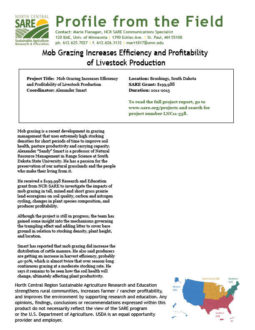Mob grazing is a recent development in grazing management that uses extremely high stocking densities for short periods of time to improve soil health, pasture productivity and carrying capacity.
Alexander “Sandy” Smart is a professor of Natural Resource Management in Range Science at South Dakota State University. He has a passion for the preservation of our natural grasslands and the people who make their living from it.
He received a $199,998 Research and Education grant from NCR-SARE to investigate the impacts of mob grazing in tall, mixed and short grass prairie land ecoregions on soil quality, carbon and nitrogen cycling, changes in plant species composition, and producer profitability.
Although the project is still in progress, the team has gained some insight into the mechanisms governing the trampling effect and adding litter to cover bare ground in relation to stocking density, plant height, and location.
Smart has reported that mob grazing did increase the distribution of cattle manure. He also said producers are getting an increase in harvest efficiency, probably 40-50%, which is almost twice that over season-long continuous grazing at a moderate stocking rate. He says it remains to be seen how the soil health will change, ultimately affecting plant productivity.
View Sandy's presentation on this project, from the 2015 Farmers Forum, through NCR-SARE's YouTube playlist. Visit www.youtube.com/NCRSAREvideo for this and other videos.
